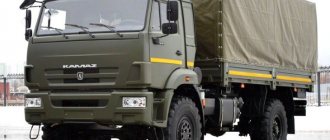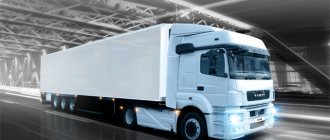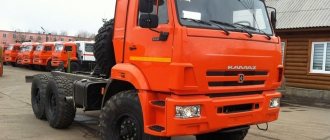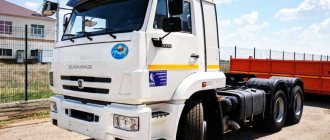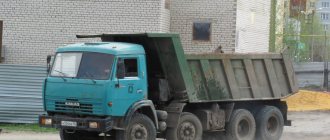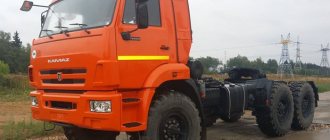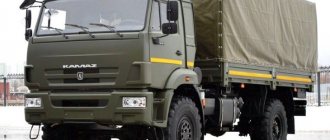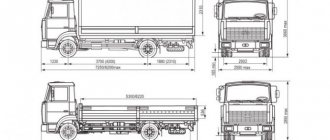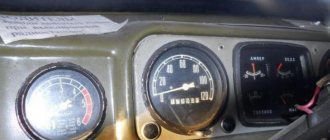KamAZ 4350 is an all-wheel drive truck with a 4 by 4 wheel arrangement. The development of equipment for transporting 30-40 people and the ability to operate in various conditions began back in the 1970s. However, the appearance of the Mustang line had to wait almost 30 years. Its first representative was the KamAZ 4326, which did not fully meet the army’s requirements, so it was soon replaced by other models with better maneuverability and cross-country ability.
The designers of the Kama Automobile Plant simultaneously developed 3 cars of the Mustang line: KamAZ 4350 (4 by 4), KamAZ 5350 (6 by 6) and KamAZ 6350 (8 by 8). These cars differed solely in the number of axles and had a high degree of unification (up to 85%).
The first prototypes were presented in 1990, their tests started a year later and turned out to be very successful. At the Kama Automobile Plant they were preparing to open serial production of the KamAZ 4350, but then there was a large-scale fire, which forced the suspension of the modification of the models. A new batch of testing machines was assembled only in 1995. At the same time, over the course of 5 years, the design of the car was noticeably altered. Thus, the chassis was modernized and a new 10-speed manual transmission was developed.
Serial production of KamAZ 4350 started in 2001. In 2007, the car’s engine line was updated (the model began to be equipped with a KamAZ-740.31-240 unit). Currently, production of the equipment continues. Most of the KamAZ 4350 produced is intended for military use.
History of creation and scope of application
Specialists from the Kama Automobile Plant began developing the multi-purpose model of the Mustang series during the existence of the USSR (in 1987).
According to the given conditions, the new truck had to withstand high-altitude conditions and operate at altitudes of up to 4000 m above sea level.
In addition to the standard cargo platform, it was planned to install operational-tactical systems and special superstructures on it.
To reduce the cost of developing a car, the designers of the Kama Automobile Plant decided to unify the components and parts of the new product as much as possible. As a result, the level of unification for the KamAZ 5350 model was 85%.
The first prototypes of an interesting truck were presented in the early 90s. The plant assembled a pilot batch in 1995, showing it at the Nizhny Novgorod exhibition.
The model contained all the advanced technical solutions of that time (dependent spring suspensions built on semi-elliptical springs, drive axles with two-stage gearboxes, power steering and a transfer case with a range-shifter).
KamAZ 5350 was the first in the brand’s line to receive a cross-axle differential locking system on the rear axle, which significantly increased its cross-country ability.
To ensure high speed in off-road conditions, the designers “awarded” the model with a range hydraulic transmission, including a classic manual gearbox and torque converter. However, it was not possible to start serial production of modifications with this transmission. The car's capabilities were significantly increased by a winch with high traction force.
Currently, production of the KamAZ 5350 model continues. At the same time, the product line of the Mustang series is constantly expanding.
So, in 2004, the Kama Automobile Plant presented two truck tractors, a version with a shortened side platform, a truck with a 15-ton payload capacity and a long-wheelbase truck, built on the basis of the KamAZ 5350 vehicle.
Chassis are also used for a number of other models: KamAZ 53502, KamAZ 53503, KamAZ 53504. Some of them are used as civilian tractors with improved technical characteristics.
At the same time, the main advantage of the model is reliability and maneuverability. KamAZ 5350 confidently drives over uneven terrain, potholes and bumps and is distinguished by high maneuverability. Due to its high technical characteristics, the model remains in demand today.
Modifications
Based on the standard KamAZ-4350, several modified versions were developed, differing in some design features. Among these models it should be noted:
KamAZ-43501.
It is a modification for military purposes. Unlike the base truck, KamAZ-43501 has a chassis shortened to 6395 millimeters and a maximum load capacity reduced to 3000 kilograms. Everything else remained virtually unchanged;
KamAZ-43501 Airborne Forces
This version also carries the KamAZ-43501-0000399-02 index. It is intended for service in the airborne troops. Excellent cross-country ability and maneuverability parameters allowed this modification to take the place of the obsolete, but very popular GAZ-66 trucks. In addition, the Kama car was quite a serious competitor to another model of the Gorky Automobile Plant, namely the two-axle all-wheel drive GAZ-3308 Sadko;
KamAZ-43502
It is an analogue of the base truck, but under the cab there is a KamAZ 740.652-260 power unit installed, which meets Euro-4 environmental requirements. The maximum load capacity has been increased to 5500 kilograms.
In addition to the above modifications, the Kama Automobile Plant presented several special vehicles, including:
KamAZ-Barkhan
It is a modified model with a hood layout, a significantly changed appearance, and a modernized transmission system. The car is intended mainly for transporting passengers and is most often used by emergency services;
KamAZ 3958 Highlander
It is a special armored vehicle with an increased protection class. In addition to protective panels, bullet-resistant laminated glass was used here, complemented by loopholes for firing;
R-142N, R-142M and R-161
They are mobile radio stations built on the basis of the standard KamAZ-4350;
NefAZ-4211-4S
This is a civilian modification intended for geologists and workers in the oil and gas industries. The model is equipped with an isothermal van from the Neftekamsk Automobile Plant.
Specifications
| 1998–2003 | 2003–2006 | 2006– | 2008– | 2015– | ||
| steering wheel location | left | |||||
| Number of doors | 2 | 2 | ||||
| number of seats | ||||||
| Total | 3 | |||||
| of them are inferior | 0 | |||||
| design | frame | |||||
| wheelbase | 3,670 mm | |||||
| Name | KamAZ | KamAZ-740.31-240 | KamAZ | Cummins ISB6.7 275 | ||
| type | Piston | |||||
| location | front, longitudinal | |||||
| block material | cast iron | |||||
| cylinders/valves | V8/2 | |||||
| fuel | diesel | Flex-fuel | diesel | |||
| cooling | liquid | |||||
| Gas distribution mechanism | SOHC | |||||
| drive unit | full | |||||
| Transmission | Manual transmission | Manual transmission (ZF 9S 1310) | Manual transmission | |||
| front suspension | ||||||
| type of elastic element | spring on longitudinal semi-elliptic springs | |||||
| guide vane type | dependent | |||||
| shock absorbers | ||||||
| adjustability | No | |||||
| rear suspension | ||||||
| type of elastic element | spring on longitudinal semi-elliptic springs | |||||
| guide vane type | dependent | |||||
| shock absorbers | ||||||
| adjustability | No | |||||
| steering type | With hydraulic booster | |||||
| front suspension type (installed) | Dependent | |||||
| rear suspension type (installed) | Dependent | |||||
| on-board voltage | 24 V | |||||
| maximum speed | 100 km/h | |||||
| Start-stop system | No | |||||
| ABS | No | |||||
| front brakes | ||||||
| type | drums | |||||
| material | metal | |||||
| perforated | No | |||||
| rear brakes | ||||||
| type | drums | |||||
| material | metal | |||||
| perforated | No | |||||
| emission standard | Euro 4 | |||||
| disc material | steel | |||||
| place of production | Naberezhnye Chelny, Tatarstan, Russian Federation | Naberezhnye Chelny, Tatarstan, Russian Federation | ||||
Engine
All models of the Mustang family are equipped with “native” engines. The plant, restored after the fire, fully supplies both the needs of KamAZ and the requests of other automobile plants with its products.
By the time the vehicles were adopted by the Russian Army, they included slightly improved 740.30-260 power plants.
The main parameters of the engines are similar - a four-stroke diesel engine with supercharging using a pair of turbochargers, each of which served its own bank of cylinders. Engine power is 260 hp, cylinder capacity is 10.85 liters. Later, the engine's power parameters were improved by increasing the boost pressure and using imported fuel equipment.
At the same time, the 740.30-260 model had some advantages over its predecessor.
They consisted of reducing fuel consumption and increasing maximum torque (from 932 to 1079 Nm) at a reduced crankshaft speed.
According to experts and reviews from army customers, the KamZA-5350 engine ensures compliance with the requirements of the technical specifications for these trucks.
Fuel consumption
On average, a car consumes about 27 liters of fuel per 100 km of travel (the figure varies depending on the type of terrain and time of year). KamAZ 5350 is equipped with a main fuel tank and an additional fuel tank with volumes of 170 and 125 liters, respectively. The power reserve is over 1000 km.
Transmission
The manufacturer installs two types of transmissions. This can be an imported ZF gearbox with 16 speeds with a divider and multiplier, or a domestic KamAZ 161 model with 10 speeds.
Both gearboxes shift mechanically and have a single-plate dry clutch. Additionally, the KamAZ-6350 truck (the tractor is not available in this version) is equipped with a transfer case and a reinforced driveshaft.
Suspension
Transporting personnel - one of the list of tasks facing army trucks - can sometimes turn into a multi-kilometer march along not the best roads. The car's suspension is designed to provide more or less comfortable driving conditions. It helps dampen and soften vibrations caused by unevenness on the road.
The suspension of the army KamAZ-5350 retained well-proven technical solutions used on production vehicles: dependent spring front suspension and a balanced rear suspension on semi-elliptical springs.
Chassis
At the front, the truck uses a dependent leaf spring suspension. The rear is balanced, on semi-elliptical springs. The wheel formula of the truck is 8 x 8.
All axles are equipped with two-stage gearboxes with constant velocity joints and differential locks. The driver can also change the tire pressure from inside the car.
The differential is also locked from the cockpit. But you can’t turn off part of the drive.
All wheels work synchronously, which increases fuel consumption. But often the path from the training ground to the army unit runs through an ordinary asphalt road.
But let's continue to look at the chassis. The KamAZ-6350 Mustang truck has both inter-axle and inter-wheel locking. The machine is built on a frame structure. The steering gear is equipped with a hydraulic booster. This control scheme has been practiced on KamAZ trucks since early models.
Brake systems
This car has four brake systems. They, if they have common elements, can, if necessary, work independently of each other:
- working - a classic version of the braking system, which serves to reduce the speed and stop the car;
- parking, familiar to any motorist, like a handbrake or handbrake;
- a spare one, which must be used to slow down and stop in case of failure of the working system;
- auxiliary, the main element of which is the gas-dynamic braking mechanism. When the gas turbine engine is turned on, it cuts off the fuel supply and the engine stalls.
The car is equipped with an alarm and control system, which provides sound and light notification in case of violations in the operation of the braking systems.
Platform and equipment options
The KamAZ-5350 platform is quite voluminous (length - 4890 mm, width - 2470 mm), and was created taking into account its use in various versions.
Currently, dump trucks, trucks for container transportation, truck cranes, tanks, drilling rigs, and technical assistance vehicles (MTA) operate on the KamAZ-5350-3014-42 chassis.
The chassis is distinguished by the installation of a 280-horsepower diesel engine and a 9-speed imported ZF gearbox with an original 2-disc clutch.
Today, the Russian army has more than 50,000 vehicles of the Mustang family in service.
It would be strange to use such powerful SUVs only for transporting personnel.
And customers, when determining the combat characteristics of the vehicle, focused on the importance of its use for purely military purposes, i.e. as a chassis for certain types of weapons and special equipment.
The KamAZ chassis today carries more than 350 types of weapons and equipment in the army.
Most often these are multiple launch rocket systems, KUNGs, maintenance vehicles, armored modules MM-501, MM-502, which can accommodate 14 people with weapons and equipment.
The module is installed in 30 minutes. It is made of 44 steel armor plates, equipped with bulletproof glass, has a rear hinged door and escape hatches.
It has a heater, fans and an intercom with the driver. The chassis has an armored cabin for three people, an engine, battery and fuel tanks protected by armor plates.
Wheels
The vehicle has 21-diameter military tires. The wheel width is 425 millimeters, the profile height is 85 percent of the total width. A distinctive feature of military KamAZ wheels is not only their large profile and powerful mud tread, but also the ability to remotely inflate tires. This system consists of:
- Pneumatic actuators.
- Shtutserov.
- Air shut-off valves (one on each wheel).
- Governing bodies.
The wheels themselves have built-in heads with cuffs for supplying air under pressure. It gets into the tires from the receiver. A sealing mechanism is built into the axle axle, through which air penetrates through the axle shaft channel into the chamber. This system is controlled from the cockpit directly by the driver. Adjustments can be made on the go.
The control is located on the lower left side of the instrument panel. The scale has a regulator for low and normal pressure. To change a parameter, just switch the knob to the appropriate position.
The exact air pressure in the tires is determined by a pressure gauge, which is also located on the instrument panel. When crossing swampy areas, the manufacturer recommends depressurizing to one atmosphere.
On sand dunes this parameter is 1.96 atmospheres.
Design Features
The device includes the following systems and mechanisms:
- Engine. The model 740.31-240 is installed here, made in accordance with the international environmental standard Euro-4. The engine is equipped with a turbocharger and an intermediate cooling system for the working fluid. The cylindrical block is made of cast iron, which increases the service life of the entire mechanism.
- Transmission. Depending on the model (4350, 53504-46, 6013 or 6030), gearbox versions such as ZF-9S109 or ZF16-9S are installed. Both models are equipped with reinforced leaf spring suspension and are controlled remotely.
- Brake system and overall diagram of the car. The brakes are equipped with two internal pads, which improves the performance of the braking mechanism. Parameters of the vehicle's cargo platform: 4.89*2.47*0.75 m.
- Electrical equipment. The electrical system includes sound and light alarms, headlights, high and low beams, a windshield wiper, as well as a heating and ventilation system in the driver's cabin.
Among the design features are:
- Light load on the rear axle.
- Loading platform parameters.
- Smooth ride even with unladen weight.
Device
KamAZ 5350 was an improved continuation of the KamAZ 4310 model with some changes. Differences were manifested in the appearance, shape of the cabin and body. Also, the more modern model received a different metal profile pattern on the body. The truck got new tires that differ in size.
The KamAZ 5350 model has retained the traditional outlines characteristic of all products of the Kama Automobile Plant. The manufacturer offered the truck in several color options: from khaki to bright orange.
The first was used primarily for military purposes and was part of camouflage. The KamAZ 5350 chassis was used in various directions, therefore the type of platform and body varied.
Tanks, flatbed trucks, truck cranes and dump trucks were produced on the basis of this model.
KamAZ 5350 is equipped with a manual 10-speed KamAZ-154 gearbox with a front divider. Transfer case 2-speed with lockable center differential. The front axle drive is permanent and cannot be switched off. The car received a differential lock on the rear axles.
The equipment cabin is designed for three people including the driver. It is quite comfortable and is additionally equipped with a special sleeping shelf. There are places intended for the installation of military equipment and special equipment. With folding benches, KamAZ 5350 can accommodate up to 39 people.
At the same time, the main direction of use of the model is military. It is no coincidence that the KamAZ 5350 is still in service in the army. Optionally, the truck cabin is equipped with class 5A armor, which allows you to protect the inside of the cabin and the crew from shots from an AKM assault rifle with 7.62 mm caliber cartridges. The equipment feels great on rough terrain.
Dimensions and load capacity
The length of KamAZ-5350 is 7960 mm, and the width and height reach 2550 and 3290 mm, respectively. Already in the standard version, the car has a ground clearance of 390 mm, and the outer turning radius is 11,300 mm.
The curb weight of the truck reaches 9800 kg, and the total weight is 15850 kg. The permissible weight of a trailer that can tow a KamAZ-5350 is 12 tons.
At the same time, the car can be praised for its carrying capacity, which reaches an impressive 6 tons. However, if the vehicle is used as part of a road train, in this case the total weight of the truck including cargo can reach 27,850 kg.
Despite such large volumes, the maximum speed of the KamAZ-5350 is 100 km/h.
The dimensions of the cargo platform are also quite impressive. So, its length is 7960 mm, and its width and height are 2470 and 730 mm, respectively.
It is noteworthy that the KamAZ-5350 has truly universal off-road capabilities. This machine is capable of climbs at angles of up to 30 degrees, and the maximum ford depth can reach 1750 mm. Moreover, the equipment is not afraid of muddy mud and deep ruts, and is capable of crossing a ditch up to 600 mm deep.
Cabin
The SUV cabin is available in several versions. The determining factor here is the purpose and requirements of the customer (for civilian customers the cabin color is usually orange, for military customers it is protective).
There are cabins with and without a berth, with a high and low roof, with two or three seats.
There is a round hatch on the roof, from which it is possible to conduct observation and fire from small arms during combat operations.
It can also be used for additional ventilation. Some army vehicles have armored cabs. Since 2010, a modernized cabin has been used, which is slightly different in appearance from the earlier version.
Fuel consumption of KamAZ vehicles
The Kama Automobile Plant, better known as KamAZ, is the largest domestic truck manufacturer. The main production of the brand is located in the Republic of Tatarstan, the city of Naberezhnye Chelny.
The history of the brand began in the 60s, when the country suddenly needed to expand its fleet of heavy-duty trucks capable of increasing the productivity of cargo transportation. However, at that time, none of the operating automobile enterprises was able to satisfy the increased demand for heavy-duty vehicles with a carrying capacity of eight to twenty tons.
In the summer of 1969, the country's Council of Ministers approved a package of documents that approved the start of construction of a new complex of automobile plants. According to the documents, the newly formed enterprise will specialize exclusively in the production of heavy trucks.
Currently, KamAZ OJSC is confidently among the top ten global companies in terms of truck production volume. The vehicles of this enterprise occupy one third of the Russian heavy-duty market. And the total number of countries where the company’s models are operated has exceeded eight dozen. KamAZ is respected not only for its reliability and maneuverability, but also for its fuel consumption per 100 km, as well as its excellent build quality.
Content
Manual
The operating instructions consist of the following parts:
- General performance characteristics of the vehicle. The operating temperature of the vehicle (-45…+40°C), the requirements for the tow hitch, and the climatic conditions in which the equipment will operate without failures are indicated here.
- Brief description of all systems. All major features of the engine, transmission, frame, fifth wheel, suspension, steering, brakes, tire pressure control, electrical equipment, etc. are presented here.
- Operation of KamAZ in the warm and cold seasons. This section describes what needs to be done to ensure that the equipment works without failures both in winter and in summer.
- Procedure and frequency of maintenance. This section indicates the procedure for carrying out maintenance, how many kilometers it is necessary to carry out maintenance 1 and 2, and also contains a list of tools that will be needed to carry out these works.
- Possible malfunctions. Here is a list of minor breakdowns and how to fix them.
- Conditions for storing a vehicle - what are the requirements for the room in which the vehicle will be parked.
Kamaz fuel consumption
The ambulance, equipped on a KamAZ-43502 chassis and designed to operate in extremely difficult climatic and road conditions, was successfully tested on the Kolyma highway in the winter of 2022, covering 1,370 km from Magadan to a number of settlements and back. Currently, at the end of 2022, the only engine equipped with KamAZ-536O5 vehicles is the Cummins ISB6 inline six-cylinder diesel engine.
About cross-country ability
Earlier we talked about the tire inflation system from the cab. What does this give? Few people know, but this is a very important parameter when crossing swampy or sandy terrain. A pronounced tread and high ground clearance are not enough for the car to confidently overcome off-road conditions.
For a larger contact area, it is necessary to remove some of the air from the tires. This is the only way to ensure the vehicle has effective cross-country ability, which the KamAZ-6350 Mustang does an excellent job of. In addition, there are air locks, a transfer case and all-wheel drive.
Reviews say that wide-profile tires and a properly designed chassis make this truck a real all-terrain vehicle.
With a length of almost 10 meters, the maximum lifting angle of the machine is 31 degrees. The depth of the ford to be overcome is up to 174 centimeters, and the ditch - 140. The maximum angle for overcoming the slope is 20 degrees.
Fuel consumption of KamAZ 65115 per 100 km
KamAZ-53605 vehicles use an original frame design that takes into account significant and uneven loads during operation, including during the process of lifting and dumping cargo with a dump platform. Of course, the use of one drive axle instead of two, in cases of identical operating conditions, both simplifies the entire design and reduces its material consumption.
Advantages
The main advantage of the all-wheel drive KamAZ is its cross-country ability. The car is capable of driving where another would get stuck up to its mirrors in a swamp. In this case, the truck can transport artillery behind it. Despite its long dimensions, this car surprises with its ability to negotiate slopes.
Also, the car has a minimum of electronics. There is essentially nothing to break here. And you can repair a car almost in the field. Even with a broken tire, this car continues its journey.
The compressor is capable of maintaining tire pressure even after several shots from a machine gun.
The truck is able to start in the most severe frost (despite the fact that it is a diesel engine) and does not overheat in the heat. By the way, many civilian KamAZ models also have a similar property. A lot of models of equipment are used in the Far North.
Engine
However, the greatest importance is given to dump truck models, since they are produced in different modifications, for each of which the fuel consumption rate will be different. 285 Fuel equipment BOSCH injection pump Fuel tank volume, l 210 210 Gearbox model KPZF 9 Clutch model 142 Suspension Spring Interaxle differential lock Yes Inter-wheel lock Yes Final drive ratio 5.94.

